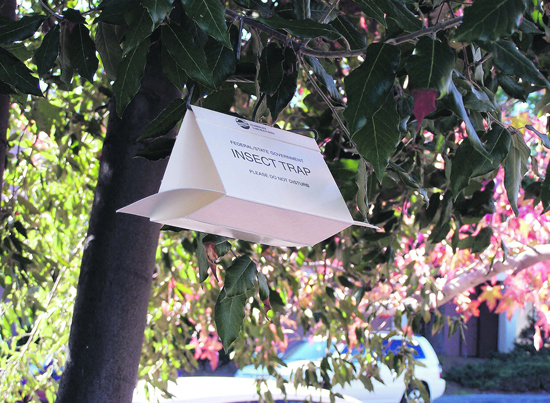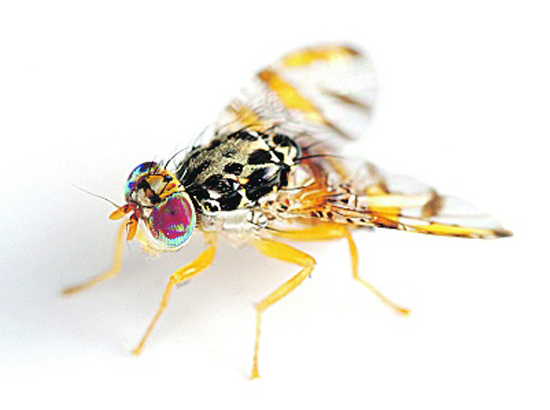| | Published August 14th, 2013
| Looking for Fruit Flies in all the Right Places
| |  | | Local residents are notified when traps are being placed on their property.
Photo provided
|
Summer for Lamorindans means warm weather, an abundance of ripening backyard fruit and plentiful travel opportunities. That is as true for fruit fly pests as it is for the human residents, which is why you may see bug traps in your neighborhood trees.
 Identifying, and hopefully containing or eradicating, any infestation is the goal of the Contra Costa County Department of Agriculture and their trusty little bug trap program. "We like to find infestations when they're small," said agricultural biologist Nancy Niemeyer. The Mediterranean fruit fly is only one of a dozen pests they seek, among them the oriental fruit fly, melon fruit fly and the gypsy moth.
Identifying, and hopefully containing or eradicating, any infestation is the goal of the Contra Costa County Department of Agriculture and their trusty little bug trap program. "We like to find infestations when they're small," said agricultural biologist Nancy Niemeyer. The Mediterranean fruit fly is only one of a dozen pests they seek, among them the oriental fruit fly, melon fruit fly and the gypsy moth.
 The aforementioned flies are about the size of a small house fly. In 2011, the business of agriculture in Contra Costa County amounted to nearly 93 million dollars. That same year the county installed over 900 bug traps. The traps containing pheromones (think bug cologne) are serviced every 7-14 days by county agricultural staff. Traps are placed among the trees each species finds most desirable.
The aforementioned flies are about the size of a small house fly. In 2011, the business of agriculture in Contra Costa County amounted to nearly 93 million dollars. That same year the county installed over 900 bug traps. The traps containing pheromones (think bug cologne) are serviced every 7-14 days by county agricultural staff. Traps are placed among the trees each species finds most desirable.
 Melon flies prefer tomatoes, Mexican fruit flies like citrus and guavas, and fruit flies in general like peaches, apricots and nectarines. Mediterranean fruit flies will eat ripe olives, which is how this writer came to have her very own bug trap placed among the branches of a front yard olive tree.
Melon flies prefer tomatoes, Mexican fruit flies like citrus and guavas, and fruit flies in general like peaches, apricots and nectarines. Mediterranean fruit flies will eat ripe olives, which is how this writer came to have her very own bug trap placed among the branches of a front yard olive tree.
 Niemeyer said California has been worried about the Mediterranean fruit fly since the early 1900s. When freight and passenger ships began arriving from Hawaii (which was infested fast and furiously by then), California became the first state to quarantine against invading pests. Recently peach fruit flies have been found in San Jose and the guava fruit fly was identified in Alameda County. An oriental fruit fly infestation in Stockton in 2011 had farmers plowing under their crops to prevent its spread.The state funded program runs seasonally from April to October or November. Field inspections are made on site and any suspicious bugs are taken to a laboratory in Sacramento for further testing.
Niemeyer said California has been worried about the Mediterranean fruit fly since the early 1900s. When freight and passenger ships began arriving from Hawaii (which was infested fast and furiously by then), California became the first state to quarantine against invading pests. Recently peach fruit flies have been found in San Jose and the guava fruit fly was identified in Alameda County. An oriental fruit fly infestation in Stockton in 2011 had farmers plowing under their crops to prevent its spread.The state funded program runs seasonally from April to October or November. Field inspections are made on site and any suspicious bugs are taken to a laboratory in Sacramento for further testing.
 "If there is an infestation, we will find it as soon as possible," Niemeyer said. She encouraged homeowners to cooperate with the county.
"If there is an infestation, we will find it as soon as possible," Niemeyer said. She encouraged homeowners to cooperate with the county.
 "Please let us use your fruit trees," she said.
"Please let us use your fruit trees," she said.

|
 | | Mediterranean fruit fly iStock Photo
|  | | A female (top) and male (bottom) European gypsy moth.
Credit: National Invasive Species Information Center
| | | | | | | | | | | |
| | | print story
Before you print this article, please remember that it will remain in our archive for you to visit anytime.
download pdf
(use the pdf document for best printing results!) | | | Comments | | |
| | | | | | | | | | | | | | | | |




